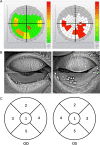Analysis of the first tear film break-up point in Sjögren's syndrome and non-Sjögren's syndrome dry eye patients
- PMID: 34980014
- PMCID: PMC8722312
- DOI: 10.1186/s12886-021-02233-6
Analysis of the first tear film break-up point in Sjögren's syndrome and non-Sjögren's syndrome dry eye patients
Abstract
Background: Tear film instability plays an important role in the course of Sjögren's Syndrome dry eye (SSDE) even though it is generally classified as aqueous-deficient dry eye. The measurement of the first tear film break-up point (FTBUP) helps to evaluate the most unstable position of the tear film on ocular surface. We aim to investigate FTBUP in Sjögren's Syndrome dry eye (SSDE) and non-Sjögren's Syndrome dry eye (NSSDE) patients, and explore its correlation with dry eye indices.
Methods: Twenty-two SSDE patients (44 eyes) and 22 NSSDE patients (44 eyes) were enrolled in the study. Oculus Keratograph K5M was used to measure FTBUP, the first and average non-invasive keratographic breakup time (f-NIKBUT and av-NIKBUT), the tear meniscus height, and meibomian gland dropout. Other tests of tear film were also performed including Ocular Surface Dryness Index (OSDI), Schirmer I test, fluorescein break-up time and corneal fluorescein staining. Dry eye indices and the locations of the FTBUP were compared between SSDE and NSSDE patients. Generalized estimating equation (GEE) was used to ajusted the correlations between right and left eyes. The correlations between the FTBUP and ocular symptoms and signs were investigated using Pearson's correlation coefficient test.
Results: The FTBUP occurred at the supranasal quadrant in 12/88 eyes, supratemporal quadrant in 8/88 eyes, inferonasal quadrant in 34/88 eyes, and inferotemporal quadrant in 34/88 eyes. The percentage eyes with inferior FTBUP was significantly higher in the SSDE than in the NSSDE subjects (86.3% vs 68.1%, P = .049). Moreover, in SSDE subjects, temporal breakup point was seen more often in those who presented corneal fluorescein staining in any location, while nasal breakup point was more frequent in those who did not present any corneal fluorescein staining (P = .045).
Conclusion: The location of the FTBUP in SSDE patients had specific characteristics. However, the diagnostic potential of FTBUP in early recognition of SSDE needs further validation.
Keywords: Non-Sjögren’s syndrome dry eye; Sjögren’s syndrome dry eye; The first tear film break-up point.
© 2021. The Author(s).
Conflict of interest statement
The authors declare that they have no competing interests.
Figures


Similar articles
-
The relation between corneal optical quality and clinical ocular surface manifestations in Chinese female with Sjogren's syndrome dry eye.BMC Ophthalmol. 2025 Jul 8;25(1):399. doi: 10.1186/s12886-025-04225-2. BMC Ophthalmol. 2025. PMID: 40629321 Free PMC article.
-
Meibomian gland dropout in Sjögren's syndrome and non-Sjögren's dry eye patients.Eye (Lond). 2018 Nov;32(11):1681-1687. doi: 10.1038/s41433-018-0149-5. Epub 2018 Jun 22. Eye (Lond). 2018. PMID: 29934634 Free PMC article.
-
Upper and lower tear menisci in Sjögren's syndrome dry eye.Invest Ophthalmol Vis Sci. 2011 Dec 9;52(13):9373-8. doi: 10.1167/iovs.11-7431. Invest Ophthalmol Vis Sci. 2011. PMID: 22025573
-
Advances in Sjögren's Syndrome Dry Eye Diagnostics: Biomarkers and Biomolecules beyond Clinical Symptoms.Biomolecules. 2024 Jan 8;14(1):80. doi: 10.3390/biom14010080. Biomolecules. 2024. PMID: 38254680 Free PMC article. Review.
-
An Overview of the Dry Eye Disease in Sjögren's Syndrome Using Our Current Molecular Understanding.Int J Mol Sci. 2023 Jan 13;24(2):1580. doi: 10.3390/ijms24021580. Int J Mol Sci. 2023. PMID: 36675090 Free PMC article. Review.
Cited by
-
Aqueous-deficient dry eye disease: Preferred practice pattern guidelines on clinical approach, diagnosis, and management.Indian J Ophthalmol. 2023 Apr;71(4):1332-1347. doi: 10.4103/IJO.IJO_2808_22. Indian J Ophthalmol. 2023. PMID: 37026265 Free PMC article. Review.
-
Dynamic Aspects of Pre-Soft Contact Lens Tear Film and Their Relation to Dry Eye: Basic Science and Clinical Relevance.Life (Basel). 2023 Mar 23;13(4):859. doi: 10.3390/life13040859. Life (Basel). 2023. PMID: 37109389 Free PMC article. Review.
-
Comparing Tear Film Viscosity between Sjögren and Non-Sjögren Dry Eye Disease.Life (Basel). 2023 Jun 30;13(7):1484. doi: 10.3390/life13071484. Life (Basel). 2023. PMID: 37511859 Free PMC article.
-
Evaporative dry eye disease due to meibomian gland dysfunction: Preferred practice pattern guidelines for diagnosis and treatment.Indian J Ophthalmol. 2023 Apr;71(4):1348-1356. doi: 10.4103/IJO.IJO_2841_22. Indian J Ophthalmol. 2023. PMID: 37026266 Free PMC article. Review.
-
Optimizing Diagnosis and Management of Dry Eye Disease: A Practical Framework for Hong Kong.Ophthalmol Ther. 2025 May;14(5):815-833. doi: 10.1007/s40123-025-01129-8. Epub 2025 Mar 26. Ophthalmol Ther. 2025. PMID: 40138170 Free PMC article.
References
-
- Wolffsohn JS, Arita R, Chalmers R, Djalilian A, Dogru M, Dumbleton K, et al. TFOS DEWS II diagnostic methodology report. Ocular Surface. 2017;15(3):539–574. - PubMed
-
- Koh S, Tung CI, Inoue Y, Jhanji V. Effects of tear film dynamics on quality of vision. Br J Ophthalmol. 2018;102(12):1615–1620. - PubMed
-
- Koh S. Irregular astigmatism and higher-order aberrations in eyes with dry eye disease. Invest Ophthalmol Vis Sci. 2018;59(14):DES36–DES40. - PubMed
-
- Wang Y, Xu J, Sun X, Chu R, Zhuang H, He JC. Dynamic wavefront aberrations and visual acuity in normal and dry eyes. Clin Exp Optom. 2009;92(3):267–273. - PubMed
MeSH terms
Substances
Grants and funding
LinkOut - more resources
Full Text Sources
Medical

